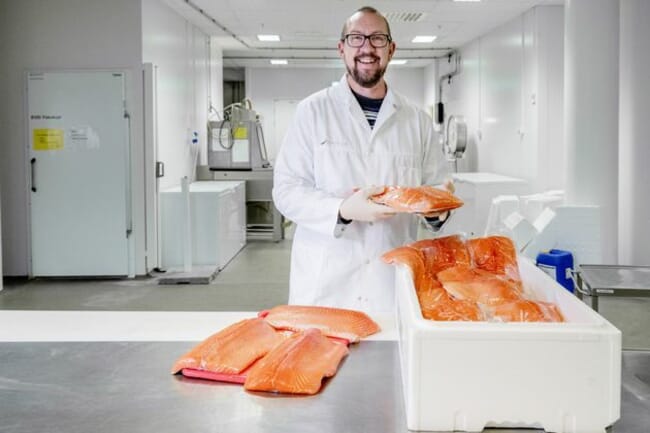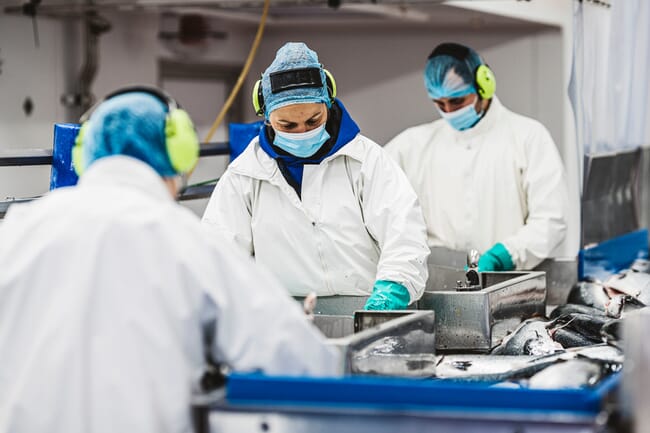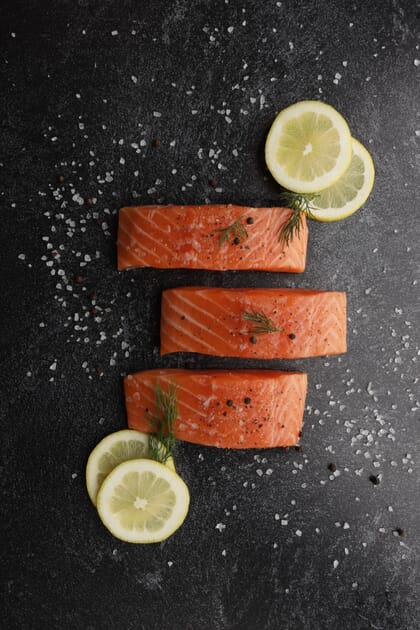
Rotabakk and his colleagues at Nofima studied the economic and environmental effects of supercooling salmon © Jan Inge Haga, Nofima
“Supercooling eliminates the need for ice in the crates, thus allowing for more salmon in each crate. More fish in each crate reduces transport needs, energy consumption and transport costs. It also significantly reduces the use of packaging,” says Nofima scientist Bjørn Tore Rotabakk.
The Fisheries and Aquaculture Industry Research Fund (FHF) is the client for the project entitled “New methods for better shelf life and more environmentally friendly transport of salmon products”. The researchers behind the report are Audun Iversen and Bjørn Tore Rotabakk from Nofima and Friederike Ziegler from the Swedish research institute Rise.
Supercooling and freezing
The study’s topic is the economic and environmental effects of supercooling salmon. Fish tissue does not freeze until it reaches a temperature of between – 0.5 and -1.5° C. When fish are quickly cooled to a temperature between 0˚ Celsius and their freezing temperature, it is called supercooling. Cooling is achieved by using subcooled liquid, dry ice or freezing technology. After supercooling, the product is packed and transported; and the temperature is kept constant as close to 0°C as possible.
The effects are highlighted by two important product flows: salmon to Europe by lorry and salmon to Asia by air transport. This results in encouraging future prospects for both the salmon industry and the environment.
Money first:
“Supercooling will reduce packing and distribution costs by almost 70 øre per kg produced for lorry transport to Europe. If all Norwegian salmon production was supercooled before transport, the industry could save NOK 1 billion in transport costs. Savings on air transport are even greater: around 2.70 per kg, or around half a billion for the entire industry,” says Nofima scientist Audun Iversen.
By using less ice the industry saves money on ice production, keeping the ice cooled and, not least, transporting it all the way to the market.
“Without ice, each crate can contain more fish. In turn this makes it possible to fill vehicles and planes with more fish. Consequently fewer lorries are required. This will also reduce packaging use and reduce shipping costs,” says Audun Iversen.
He points out that supercooling can reduce the use of packaging and transport by up to 20 percent. This means that around 15,000 lorry loads of salmon, and as many returning lorries, can be removed from the roads. There is also the transport of crates from crate factories to the slaughterhouses.

Supercooling salmon can reduce greenhouse gas emissions during the processing stage © Scottish Sea Farms
Reduced energy use
Supercooling the salmon before transport also saves on energy costs. Additional energy consumption associated with tank cooling amounts to 7 KWh per tonne of salmon produced. The company also saves 21 KWh per tonne on ice production, resulting in a net reduction in electricity consumption of 14 KWh per tonne of salmon produced. There is also increased use of salt – 52.5 kg per tonne of salmon. And extra water, 1,500 litres per tonne of salmon. All environmental effect calculations are made with an assumption of 26 kg of salmon per crate instead of 21.5 kg.

Greenhouse gas emissions related to slaughter, packing and transport of salmon can be greatly reduced if supercooling was used © Mowi
“Not using ice also means there is no runoff of meltwater on lorries. This is a major advantage in terms of road safety and reputation, but we have not tried to value it here,” says Bjørn-Tore Rotabakk.
Eliminated runoff is also good for the environmental accounts, but is a small factor compared to other environmental benefits of supercooling.
Reduced greenhouse gas emissions
The report also concludes that greenhouse gas emissions related to slaughter, packing and transport of salmon can be greatly reduced. Such a reduction is estimated to amount to around 15 percent for salmon transported by lorry to Europe and around 17 percent for salmon transported by air to Asia.
“Transport to the market accounts for only 1 percent of the total emissions for salmon transported by lorry to Europe, while feed accounts for almost 70 percent of emissions. On the other hand, when fish are sent to Asia by plane, transport accounts for more than half of the emissions. Therefore, a change of 17 percent also has a major impact on total emissions which are thus reduced by almost 8 to 9 percent,” Audun Iversen points out.




